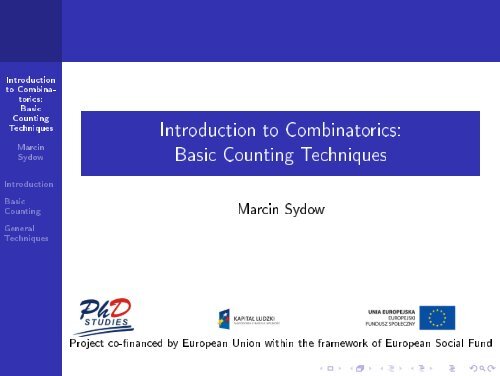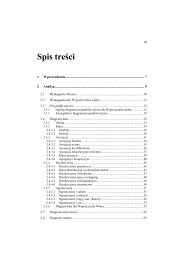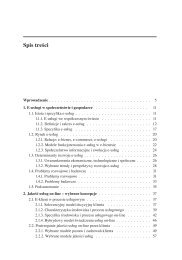Introduction to Combinatorics: Basic Counting Techniques - pjwstk
Introduction to Combinatorics: Basic Counting Techniques - pjwstk
Introduction to Combinatorics: Basic Counting Techniques - pjwstk
Create successful ePaper yourself
Turn your PDF publications into a flip-book with our unique Google optimized e-Paper software.
<strong>Introduction</strong><br />
<strong>to</strong> Combina<strong>to</strong>rics:<br />
<strong>Basic</strong><br />
<strong>Counting</strong><br />
<strong>Techniques</strong><br />
Marcin<br />
Sydow<br />
<strong>Introduction</strong> <strong>to</strong> Combina<strong>to</strong>rics:<br />
<strong>Basic</strong> <strong>Counting</strong> <strong>Techniques</strong><br />
<strong>Introduction</strong><br />
<strong>Basic</strong><br />
<strong>Counting</strong><br />
General<br />
<strong>Techniques</strong><br />
Marcin Sydow<br />
Project co-nanced by European Union within the framework of European Social Fund
Literature<br />
<strong>Introduction</strong><br />
<strong>to</strong> Combina<strong>to</strong>rics:<br />
<strong>Basic</strong><br />
<strong>Counting</strong><br />
<strong>Techniques</strong><br />
Marcin<br />
Sydow<br />
<strong>Introduction</strong><br />
<strong>Basic</strong><br />
<strong>Counting</strong><br />
General<br />
<strong>Techniques</strong><br />
Combina<strong>to</strong>rics:<br />
D.Knuth et al. Concrete Mathematics (also available in<br />
Polish, PWN 1998)<br />
M.Libura et al. Wykªady z Matematyki Dyskretnej, cz.1<br />
Kombina<strong>to</strong>ryka, skrypt WSISIZ, Warszawa 2001<br />
M.Lipski Kombina<strong>to</strong>ryka dla programistów, WNT 2004<br />
Van Lint et al. A Course in Combina<strong>to</strong>rics, Cambridge<br />
2001<br />
Graphs:<br />
R.Wilson <strong>Introduction</strong> <strong>to</strong> Graph Theory (also available in<br />
Polish, PWN 2000)<br />
R.Diestel Graph Theory, Springer 2000
Contents<br />
<strong>Introduction</strong><br />
<strong>to</strong> Combina<strong>to</strong>rics:<br />
<strong>Basic</strong><br />
<strong>Counting</strong><br />
<strong>Techniques</strong><br />
Marcin<br />
Sydow<br />
<strong>Introduction</strong><br />
<strong>Basic</strong><br />
<strong>Counting</strong><br />
General<br />
<strong>Techniques</strong><br />
<strong>Basic</strong> <strong>Counting</strong><br />
Reminder of basic facts<br />
Binomial Coecient<br />
Multinomial Coecient<br />
Multisets<br />
Set Partitions<br />
Number Partitions<br />
Permutations and Cycles<br />
General <strong>Techniques</strong><br />
Pigeonhole Principle<br />
Inclusion-Exclusion Principle<br />
Generating Functions
General <strong>Basic</strong> Ideas for <strong>Counting</strong><br />
<strong>Introduction</strong><br />
<strong>to</strong> Combina<strong>to</strong>rics:<br />
<strong>Basic</strong><br />
<strong>Counting</strong><br />
<strong>Techniques</strong><br />
Marcin<br />
Sydow<br />
<strong>Introduction</strong><br />
<strong>Basic</strong><br />
<strong>Counting</strong><br />
General<br />
<strong>Techniques</strong><br />
create easy-<strong>to</strong>-count representations of counted objects<br />
product rule: multiply when choices are independent<br />
sum rule: sum up exclusive alternatives<br />
combina<strong>to</strong>rial interpretation proving technique<br />
These ideas can be used not only <strong>to</strong> count objects but also <strong>to</strong><br />
easily prove non-trivial discrete-maths identities (examples<br />
soon)
<strong>Counting</strong> <strong>Basic</strong> Objects<br />
<strong>Introduction</strong><br />
<strong>to</strong> Combina<strong>to</strong>rics:<br />
<strong>Basic</strong><br />
<strong>Counting</strong><br />
<strong>Techniques</strong><br />
Marcin<br />
Sydow<br />
<strong>Introduction</strong><br />
<strong>Basic</strong><br />
<strong>Counting</strong><br />
Denotations: # means: the number of<br />
[n] means: the set {1,...,n}, for n ∈ N<br />
n, m ∈ N<br />
(# functions from [m] in<strong>to</strong> [n]) |Fun([m], [n])| =<br />
General<br />
<strong>Techniques</strong>
<strong>Counting</strong> <strong>Basic</strong> Objects<br />
<strong>Introduction</strong><br />
<strong>to</strong> Combina<strong>to</strong>rics:<br />
<strong>Basic</strong><br />
<strong>Counting</strong><br />
<strong>Techniques</strong><br />
Marcin<br />
Sydow<br />
<strong>Introduction</strong><br />
<strong>Basic</strong><br />
<strong>Counting</strong><br />
Denotations: # means: the number of<br />
[n] means: the set {1,...,n}, for n ∈ N<br />
n, m ∈ N<br />
(# functions from [m] in<strong>to</strong> [n]) |Fun([m], [n])| = n m<br />
(# subsets of an n-element set) |P([n])| =<br />
General<br />
<strong>Techniques</strong>
<strong>Counting</strong> <strong>Basic</strong> Objects<br />
<strong>Introduction</strong><br />
<strong>to</strong> Combina<strong>to</strong>rics:<br />
<strong>Basic</strong><br />
<strong>Counting</strong><br />
<strong>Techniques</strong><br />
Marcin<br />
Sydow<br />
<strong>Introduction</strong><br />
<strong>Basic</strong><br />
<strong>Counting</strong><br />
General<br />
<strong>Techniques</strong><br />
Denotations: # means: the number of<br />
[n] means: the set {1,...,n}, for n ∈ N<br />
n, m ∈ N<br />
(# functions from [m] in<strong>to</strong> [n]) |Fun([m], [n])| = n m<br />
(# subsets of an n-element set) |P([n])| = 2 n<br />
(# injections as above) |Inj([m], [n])| =
<strong>Counting</strong> <strong>Basic</strong> Objects<br />
<strong>Introduction</strong><br />
<strong>to</strong> Combina<strong>to</strong>rics:<br />
<strong>Basic</strong><br />
<strong>Counting</strong><br />
<strong>Techniques</strong><br />
Marcin<br />
Sydow<br />
<strong>Introduction</strong><br />
<strong>Basic</strong><br />
<strong>Counting</strong><br />
General<br />
<strong>Techniques</strong><br />
Denotations: # means: the number of<br />
[n] means: the set {1,...,n}, for n ∈ N<br />
n, m ∈ N<br />
(# functions from [m] in<strong>to</strong> [n]) |Fun([m], [n])| = n m<br />
(# subsets of an n-element set) |P([n])| = 2 n<br />
(# injections as above) |Inj([m], [n])| = n m for n ≥ m (called<br />
falling fac<strong>to</strong>rial)<br />
# ordered placings of m dierent balls in<strong>to</strong> n dierent boxes :
<strong>Counting</strong> <strong>Basic</strong> Objects<br />
<strong>Introduction</strong><br />
<strong>to</strong> Combina<strong>to</strong>rics:<br />
<strong>Basic</strong><br />
<strong>Counting</strong><br />
<strong>Techniques</strong><br />
Marcin<br />
Sydow<br />
<strong>Introduction</strong><br />
<strong>Basic</strong><br />
<strong>Counting</strong><br />
General<br />
<strong>Techniques</strong><br />
Denotations: # means: the number of<br />
[n] means: the set {1,...,n}, for n ∈ N<br />
n, m ∈ N<br />
(# functions from [m] in<strong>to</strong> [n]) |Fun([m], [n])| = n m<br />
(# subsets of an n-element set) |P([n])| = 2 n<br />
(# injections as above) |Inj([m], [n])| = n m for n ≥ m (called<br />
falling fac<strong>to</strong>rial)<br />
# ordered placings of m dierent balls in<strong>to</strong> n dierent boxes : n ©m<br />
(called increasing power)<br />
(# permutations of [n]) |S n | =
<strong>Counting</strong> <strong>Basic</strong> Objects<br />
<strong>Introduction</strong><br />
<strong>to</strong> Combina<strong>to</strong>rics:<br />
<strong>Basic</strong><br />
<strong>Counting</strong><br />
<strong>Techniques</strong><br />
Marcin<br />
Sydow<br />
<strong>Introduction</strong><br />
<strong>Basic</strong><br />
<strong>Counting</strong><br />
General<br />
<strong>Techniques</strong><br />
Denotations: # means: the number of<br />
[n] means: the set {1,...,n}, for n ∈ N<br />
n, m ∈ N<br />
(# functions from [m] in<strong>to</strong> [n]) |Fun([m], [n])| = n m<br />
(# subsets of an n-element set) |P([n])| = 2 n<br />
(# injections as above) |Inj([m], [n])| = n m for n ≥ m (called<br />
falling fac<strong>to</strong>rial)<br />
# ordered placings of m dierent balls in<strong>to</strong> n dierent boxes : n ©m<br />
(called increasing power)<br />
(# permutations of [n]) |S n | = n!
Binomial Coecient<br />
<strong>Introduction</strong><br />
<strong>to</strong> Combina<strong>to</strong>rics:<br />
<strong>Basic</strong><br />
<strong>Counting</strong><br />
<strong>Techniques</strong><br />
Marcin<br />
Sydow<br />
<strong>Introduction</strong><br />
<strong>Basic</strong><br />
<strong>Counting</strong><br />
General<br />
<strong>Techniques</strong><br />
# k-subsets of [n]<br />
( n<br />
k<br />
)<br />
= nk<br />
k!<br />
N ∋ k ≤ n ∈ N<br />
(there is also possible a more general formulation for<br />
non-natural numbers)
Recursive formulation<br />
<strong>Introduction</strong><br />
<strong>to</strong> Combina<strong>to</strong>rics:<br />
<strong>Basic</strong><br />
<strong>Counting</strong><br />
<strong>Techniques</strong><br />
Marcin<br />
Sydow<br />
<strong>Introduction</strong><br />
<strong>Basic</strong><br />
<strong>Counting</strong><br />
( n<br />
k<br />
)<br />
=<br />
( n − 1<br />
k − 1<br />
) ( n − 1<br />
+<br />
k<br />
(also known as Pascal's triangle)<br />
)<br />
General<br />
<strong>Techniques</strong>
Recursive formulation<br />
<strong>Introduction</strong><br />
<strong>to</strong> Combina<strong>to</strong>rics:<br />
<strong>Basic</strong><br />
<strong>Counting</strong><br />
<strong>Techniques</strong><br />
Marcin<br />
Sydow<br />
<strong>Introduction</strong><br />
<strong>Basic</strong><br />
<strong>Counting</strong><br />
General<br />
<strong>Techniques</strong><br />
( n<br />
k<br />
)<br />
=<br />
( n − 1<br />
k − 1<br />
) ( n − 1<br />
+<br />
k<br />
(also known as Pascal's triangle)<br />
how <strong>to</strong> prove it without (almost) any algebra<br />
(use combina<strong>to</strong>rial interpretation idea)<br />
)
Recursive formulation<br />
<strong>Introduction</strong><br />
<strong>to</strong> Combina<strong>to</strong>rics:<br />
<strong>Basic</strong><br />
<strong>Counting</strong><br />
<strong>Techniques</strong><br />
Marcin<br />
Sydow<br />
<strong>Introduction</strong><br />
<strong>Basic</strong><br />
<strong>Counting</strong><br />
General<br />
<strong>Techniques</strong><br />
( n<br />
k<br />
)<br />
=<br />
( n − 1<br />
k − 1<br />
) ( n − 1<br />
+<br />
k<br />
(also known as Pascal's triangle)<br />
how <strong>to</strong> prove it without (almost) any algebra<br />
(use combina<strong>to</strong>rial interpretation idea)<br />
(consider whether one xed element of [n] belongs <strong>to</strong> the<br />
k-subset or not)<br />
)
<strong>Basic</strong> properties<br />
<strong>Introduction</strong><br />
<strong>to</strong> Combina<strong>to</strong>rics:<br />
<strong>Basic</strong><br />
<strong>Counting</strong><br />
<strong>Techniques</strong><br />
Marcin<br />
Sydow<br />
Symmetry:<br />
( n<br />
k<br />
)<br />
=<br />
( n<br />
n − k<br />
)<br />
<strong>Introduction</strong><br />
<strong>Basic</strong><br />
<strong>Counting</strong><br />
General<br />
<strong>Techniques</strong>
<strong>Basic</strong> properties<br />
<strong>Introduction</strong><br />
<strong>to</strong> Combina<strong>to</strong>rics:<br />
<strong>Basic</strong><br />
<strong>Counting</strong><br />
<strong>Techniques</strong><br />
Marcin<br />
Sydow<br />
<strong>Introduction</strong><br />
( ) ( )<br />
n n<br />
Symmetry: =<br />
k n − k<br />
(each k-subset denes (n-k)-subset its complement)<br />
<strong>Basic</strong><br />
<strong>Counting</strong><br />
General<br />
<strong>Techniques</strong>
<strong>Basic</strong> properties<br />
<strong>Introduction</strong><br />
<strong>to</strong> Combina<strong>to</strong>rics:<br />
<strong>Basic</strong><br />
<strong>Counting</strong><br />
<strong>Techniques</strong><br />
Marcin<br />
Sydow<br />
<strong>Introduction</strong><br />
<strong>Basic</strong><br />
<strong>Counting</strong><br />
General<br />
<strong>Techniques</strong><br />
( ) ( )<br />
n n<br />
Symmetry: =<br />
k n − k<br />
(each k-subset denes (n-k)-subset its complement)<br />
n∑<br />
( ) n<br />
= 2 n<br />
k<br />
k=0
<strong>Basic</strong> properties<br />
<strong>Introduction</strong><br />
<strong>to</strong> Combina<strong>to</strong>rics:<br />
<strong>Basic</strong><br />
<strong>Counting</strong><br />
<strong>Techniques</strong><br />
Marcin<br />
Sydow<br />
<strong>Introduction</strong><br />
<strong>Basic</strong><br />
<strong>Counting</strong><br />
General<br />
<strong>Techniques</strong><br />
( ) ( )<br />
n n<br />
Symmetry: =<br />
k n − k<br />
(each k-subset denes (n-k)-subset its complement)<br />
n∑<br />
( ) n<br />
= 2 n<br />
k<br />
k=0<br />
(summing subsets of [n] by their multiplicity)
<strong>Basic</strong> properties<br />
<strong>Introduction</strong><br />
<strong>to</strong> Combina<strong>to</strong>rics:<br />
<strong>Basic</strong><br />
<strong>Counting</strong><br />
<strong>Techniques</strong><br />
Marcin<br />
Sydow<br />
( n<br />
k<br />
) ( k<br />
m<br />
) ( n<br />
=<br />
m<br />
) ( n − m<br />
n − k<br />
)<br />
<strong>Introduction</strong><br />
<strong>Basic</strong><br />
<strong>Counting</strong><br />
General<br />
<strong>Techniques</strong>
<strong>Basic</strong> properties<br />
<strong>Introduction</strong><br />
<strong>to</strong> Combina<strong>to</strong>rics:<br />
<strong>Basic</strong><br />
<strong>Counting</strong><br />
<strong>Techniques</strong><br />
Marcin<br />
Sydow<br />
<strong>Introduction</strong><br />
<strong>Basic</strong><br />
<strong>Counting</strong><br />
( ) ( ) ( ) ( )<br />
n k n n − m<br />
=<br />
k m m n − k<br />
(consider m-element subset of o k-element subset of [n])<br />
General<br />
<strong>Techniques</strong>
<strong>Basic</strong> properties<br />
<strong>Introduction</strong><br />
<strong>to</strong> Combina<strong>to</strong>rics:<br />
<strong>Basic</strong><br />
<strong>Counting</strong><br />
<strong>Techniques</strong><br />
Marcin<br />
Sydow<br />
<strong>Introduction</strong><br />
<strong>Basic</strong><br />
<strong>Counting</strong><br />
General<br />
<strong>Techniques</strong><br />
( ) ( ) ( ) ( )<br />
n k n n − m<br />
=<br />
k m m n − k<br />
(consider m-element subset of o k-element subset of [n])<br />
( m + n<br />
k<br />
)<br />
=<br />
k∑<br />
( m<br />
s<br />
s=0<br />
) ( n<br />
k − s<br />
)
Binomial Theorem<br />
<strong>Introduction</strong><br />
<strong>to</strong> Combina<strong>to</strong>rics:<br />
<strong>Basic</strong><br />
<strong>Counting</strong><br />
<strong>Techniques</strong><br />
Marcin<br />
Sydow<br />
<strong>Introduction</strong><br />
<strong>Basic</strong><br />
<strong>Counting</strong><br />
General<br />
<strong>Techniques</strong><br />
(x + y) n =<br />
n∑<br />
( ) n<br />
x k y n−k<br />
k<br />
k=0<br />
(explanation: each term on the right may be represented as a<br />
k-subset of [n])<br />
Corollaries:<br />
# odd subsets of [n] equals # even subsets
Binomial Theorem<br />
<strong>Introduction</strong><br />
<strong>to</strong> Combina<strong>to</strong>rics:<br />
<strong>Basic</strong><br />
<strong>Counting</strong><br />
<strong>Techniques</strong><br />
Marcin<br />
Sydow<br />
<strong>Introduction</strong><br />
<strong>Basic</strong><br />
<strong>Counting</strong><br />
General<br />
<strong>Techniques</strong><br />
(x + y) n =<br />
n∑<br />
( ) n<br />
x k y n−k<br />
k<br />
k=0<br />
(explanation: each term on the right may be represented as a<br />
k-subset of [n])<br />
Corollaries:<br />
# odd subsets of [n] equals # even subsets (substitute<br />
x=1 and y=-1)
Binomial Theorem<br />
<strong>Introduction</strong><br />
<strong>to</strong> Combina<strong>to</strong>rics:<br />
<strong>Basic</strong><br />
<strong>Counting</strong><br />
<strong>Techniques</strong><br />
Marcin<br />
Sydow<br />
<strong>Introduction</strong><br />
<strong>Basic</strong><br />
<strong>Counting</strong><br />
General<br />
<strong>Techniques</strong><br />
(x + y) n =<br />
n∑<br />
( ) n<br />
x k y n−k<br />
k<br />
k=0<br />
(explanation: each term on the right may be represented as a<br />
k-subset of [n])<br />
Corollaries:<br />
# odd subsets of [n] equals # even subsets (substitute<br />
x=1 and y=-1)<br />
n∑<br />
( ) n<br />
k = n2 n−1<br />
k<br />
k=0<br />
(take derivative (as function of x) of both sides and then<br />
subsitute x=y=1)
Multinomial Coecient<br />
<strong>Introduction</strong><br />
<strong>to</strong> Combina<strong>to</strong>rics:<br />
<strong>Basic</strong><br />
<strong>Counting</strong><br />
<strong>Techniques</strong><br />
Marcin<br />
Sydow<br />
<strong>Introduction</strong><br />
<strong>Basic</strong><br />
<strong>Counting</strong><br />
General<br />
<strong>Techniques</strong><br />
(a generalisation of the binomial coecient)<br />
# colourings of n balls with at most m dierent colours so that<br />
exactly k i ∈ N balls have the i-th colour<br />
(<br />
)<br />
n<br />
=<br />
k 1 k 2 . . . k m<br />
n!<br />
k 1 ! · . . . · k m !
Multinomial Coecient<br />
<strong>Introduction</strong><br />
<strong>to</strong> Combina<strong>to</strong>rics:<br />
<strong>Basic</strong><br />
<strong>Counting</strong><br />
<strong>Techniques</strong><br />
Marcin<br />
Sydow<br />
<strong>Introduction</strong><br />
<strong>Basic</strong><br />
<strong>Counting</strong><br />
General<br />
<strong>Techniques</strong><br />
(a generalisation of the binomial coecient)<br />
# colourings of n balls with at most m dierent colours so that<br />
exactly k i ∈ N balls have the i-th colour<br />
(<br />
)<br />
n<br />
=<br />
k 1 k 2 . . . k m<br />
n!<br />
k 1 ! · . . . · k m !<br />
(x the sequence (k) i and x a permutation of [n] <strong>to</strong> be<br />
coloured)
Multinomial Theorem<br />
<strong>Introduction</strong><br />
<strong>to</strong> Combina<strong>to</strong>rics:<br />
<strong>Basic</strong><br />
<strong>Counting</strong><br />
<strong>Techniques</strong><br />
Marcin<br />
Sydow<br />
<strong>Introduction</strong><br />
(x 1 +. . .+x m ) n =<br />
∑<br />
k 1 , . . . , k m ∈ N<br />
k 1 + . . . + k m = n<br />
(<br />
)<br />
n<br />
x k 1 km<br />
1 ·. . .·xm<br />
k 1 k 2 . . . k m<br />
<strong>Basic</strong><br />
<strong>Counting</strong><br />
General<br />
<strong>Techniques</strong><br />
Corollary:<br />
∑<br />
k 1 , . . . , k m ∈ N<br />
k 1 + . . . + k m = n<br />
(<br />
n<br />
k 1 k 2 . . . k m<br />
)<br />
= m n
Multinomial Theorem<br />
<strong>Introduction</strong><br />
<strong>to</strong> Combina<strong>to</strong>rics:<br />
<strong>Basic</strong><br />
<strong>Counting</strong><br />
<strong>Techniques</strong><br />
Marcin<br />
Sydow<br />
<strong>Introduction</strong><br />
(x 1 +. . .+x m ) n =<br />
∑<br />
k 1 , . . . , k m ∈ N<br />
k 1 + . . . + k m = n<br />
(<br />
)<br />
n<br />
x k 1 km<br />
1 ·. . .·xm<br />
k 1 k 2 . . . k m<br />
<strong>Basic</strong><br />
<strong>Counting</strong><br />
General<br />
<strong>Techniques</strong><br />
Corollary:<br />
∑<br />
k 1 , . . . , k m ∈ N<br />
k 1 + . . . + k m = n<br />
(<br />
)<br />
n<br />
= m n<br />
k 1 k 2 . . . k m<br />
(substitute all 1's on the left-hand side)
Recursive Formula<br />
<strong>Introduction</strong><br />
<strong>to</strong> Combina<strong>to</strong>rics:<br />
<strong>Basic</strong><br />
<strong>Counting</strong><br />
<strong>Techniques</strong><br />
Marcin<br />
Sydow<br />
<strong>Introduction</strong><br />
<strong>Basic</strong><br />
<strong>Counting</strong><br />
General<br />
<strong>Techniques</strong><br />
(<br />
) (<br />
n<br />
=<br />
k 1 k 2 . . . k m<br />
) (<br />
n − 1<br />
+<br />
k 1 − 1 k 2 . . . k m<br />
(<br />
+ . . . +<br />
n − 1<br />
k 1 k 2 . . . k m − 1<br />
)<br />
n − 1<br />
+<br />
k 1 k 2 − 1 . . . k m<br />
)
Recursive Formula<br />
<strong>Introduction</strong><br />
<strong>to</strong> Combina<strong>to</strong>rics:<br />
<strong>Basic</strong><br />
<strong>Counting</strong><br />
<strong>Techniques</strong><br />
Marcin<br />
Sydow<br />
<strong>Introduction</strong><br />
<strong>Basic</strong><br />
<strong>Counting</strong><br />
General<br />
<strong>Techniques</strong><br />
(<br />
) (<br />
n<br />
=<br />
k 1 k 2 . . . k m<br />
) (<br />
n − 1<br />
+<br />
k 1 − 1 k 2 . . . k m<br />
(<br />
+ . . . +<br />
n − 1<br />
k 1 k 2 . . . k m − 1<br />
)<br />
n − 1<br />
+<br />
k 1 k 2 − 1 . . . k m<br />
(explanation: x one element of [n] and analogously <strong>to</strong> the<br />
binomial theorem)<br />
)
Multisets<br />
<strong>Introduction</strong><br />
<strong>to</strong> Combina<strong>to</strong>rics:<br />
<strong>Basic</strong><br />
<strong>Counting</strong><br />
<strong>Techniques</strong><br />
Marcin<br />
Sydow<br />
Element of type x i has k i (identical) copies.<br />
Q =< k 1 ∗ x 1 , . . . , k n ∗ x n ><br />
<strong>Introduction</strong><br />
<strong>Basic</strong><br />
<strong>Counting</strong><br />
General<br />
<strong>Techniques</strong><br />
Subset S of Q:<br />
S =< m 1 ∗ x 1 , . . . , m n ∗ x n ><br />
(0 ≤ m i ≤ k i , for i ∈ [n])<br />
Fact:<br />
# subsets of Q = <br />
|Q| = k 1 + . . . + k n
Multisets<br />
<strong>Introduction</strong><br />
<strong>to</strong> Combina<strong>to</strong>rics:<br />
<strong>Basic</strong><br />
<strong>Counting</strong><br />
<strong>Techniques</strong><br />
Marcin<br />
Sydow<br />
Element of type x i has k i (identical) copies.<br />
Q =< k 1 ∗ x 1 , . . . , k n ∗ x n ><br />
<strong>Introduction</strong><br />
<strong>Basic</strong><br />
<strong>Counting</strong><br />
General<br />
<strong>Techniques</strong><br />
Subset S of Q:<br />
S =< m 1 ∗ x 1 , . . . , m n ∗ x n ><br />
(0 ≤ m i ≤ k i , for i ∈ [n])<br />
|Q| = k 1 + . . . + k n<br />
Fact:<br />
# subsets of Q = (1 + k 1 ) · (1 + k 2 ) · . . . · (1 + k n )
Partitions of number n in<strong>to</strong> sum of k terms<br />
<strong>Introduction</strong><br />
<strong>to</strong> Combina<strong>to</strong>rics:<br />
<strong>Basic</strong><br />
<strong>Counting</strong><br />
<strong>Techniques</strong><br />
Marcin<br />
Sydow<br />
<strong>Introduction</strong><br />
<strong>Basic</strong><br />
<strong>Counting</strong><br />
General<br />
<strong>Techniques</strong><br />
P(n, k)<br />
# k-partitions of n, n ∈ N<br />
Partition of n: n = a 1 + . . . + a k , a 1 ≥ . . . ≥ a k > 0<br />
Recursive formula:<br />
P(n, k) = P(n − 1, k − 1) + P(n − k, k)
Partitions of number n in<strong>to</strong> sum of k terms<br />
<strong>Introduction</strong><br />
<strong>to</strong> Combina<strong>to</strong>rics:<br />
<strong>Basic</strong><br />
<strong>Counting</strong><br />
<strong>Techniques</strong><br />
Marcin<br />
Sydow<br />
<strong>Introduction</strong><br />
<strong>Basic</strong><br />
<strong>Counting</strong><br />
General<br />
<strong>Techniques</strong><br />
P(n, k)<br />
# k-partitions of n, n ∈ N<br />
Partition of n: n = a 1 + . . . + a k , a 1 ≥ . . . ≥ a k > 0<br />
Recursive formula:<br />
P(n, k) = P(n − 1, k − 1) + P(n − k, k)<br />
(either a k = 1 or all blocks can be decreased by 1 element)
Partitions of number n in<strong>to</strong> sum of k terms<br />
<strong>Introduction</strong><br />
<strong>to</strong> Combina<strong>to</strong>rics:<br />
<strong>Basic</strong><br />
<strong>Counting</strong><br />
<strong>Techniques</strong><br />
Marcin<br />
Sydow<br />
<strong>Introduction</strong><br />
<strong>Basic</strong><br />
<strong>Counting</strong><br />
General<br />
<strong>Techniques</strong><br />
P(n, k)<br />
# k-partitions of n, n ∈ N<br />
Partition of n: n = a 1 + . . . + a k , a 1 ≥ . . . ≥ a k > 0<br />
Recursive formula:<br />
P(n, k) = P(n − 1, k − 1) + P(n − k, k)<br />
(either a k = 1 or all blocks can be decreased by 1 element)<br />
Fact:<br />
P(n, k) =<br />
k∑<br />
P(n − k, i)<br />
i=0
Partitions of number n in<strong>to</strong> sum of k terms<br />
<strong>Introduction</strong><br />
<strong>to</strong> Combina<strong>to</strong>rics:<br />
<strong>Basic</strong><br />
<strong>Counting</strong><br />
<strong>Techniques</strong><br />
Marcin<br />
Sydow<br />
# k-partitions of n, n ∈ N<br />
P(n, k)<br />
Partition of n: n = a 1 + . . . + a k , a 1 ≥ . . . ≥ a k > 0<br />
<strong>Introduction</strong><br />
<strong>Basic</strong><br />
<strong>Counting</strong><br />
General<br />
<strong>Techniques</strong><br />
Recursive formula:<br />
P(n, k) = P(n − 1, k − 1) + P(n − k, k)<br />
(either a k = 1 or all blocks can be decreased by 1 element)<br />
Fact:<br />
k∑<br />
P(n, k) = P(n − k, i)<br />
i=0<br />
(decrease by 1 each of i terms greater than 1)
Set Partitions<br />
<strong>Introduction</strong><br />
<strong>to</strong> Combina<strong>to</strong>rics:<br />
<strong>Basic</strong><br />
<strong>Counting</strong><br />
<strong>Techniques</strong><br />
Marcin<br />
Sydow<br />
<strong>Introduction</strong><br />
<strong>Basic</strong><br />
<strong>Counting</strong><br />
General<br />
<strong>Techniques</strong><br />
Partition of nite set X in<strong>to</strong> k blocks: Π k = A 1 , . . . , A k so that:<br />
∀ 1≤i≤k A i ≠ ∅<br />
A 1 ∪ . . . ∪ A k = X<br />
∀ 1≤i
Stirling Number of the 2nd kind<br />
<strong>Introduction</strong><br />
<strong>to</strong> Combina<strong>to</strong>rics:<br />
<strong>Basic</strong><br />
<strong>Counting</strong><br />
<strong>Techniques</strong><br />
{ n<br />
k<br />
}<br />
= |Π k ([n])|<br />
Marcin<br />
Sydow<br />
<strong>Introduction</strong><br />
<strong>Basic</strong><br />
<strong>Counting</strong><br />
General<br />
<strong>Techniques</strong><br />
(# partitions of [n] in<strong>to</strong> k blocks)<br />
Recursive formula:<br />
{ } { }<br />
n n<br />
= 1 = 0 for n > 0<br />
n 0<br />
{ n<br />
k<br />
}<br />
=<br />
{ n − 1<br />
k − 1<br />
} { n − 1<br />
+ k<br />
k<br />
}
Stirling Number of the 2nd kind<br />
<strong>Introduction</strong><br />
<strong>to</strong> Combina<strong>to</strong>rics:<br />
<strong>Basic</strong><br />
<strong>Counting</strong><br />
<strong>Techniques</strong><br />
{ n<br />
k<br />
}<br />
= |Π k ([n])|<br />
Marcin<br />
Sydow<br />
<strong>Introduction</strong><br />
<strong>Basic</strong><br />
<strong>Counting</strong><br />
General<br />
<strong>Techniques</strong><br />
(# partitions of [n] in<strong>to</strong> k blocks)<br />
Recursive formula:<br />
{ } { }<br />
n n<br />
= 1 = 0 for n > 0<br />
n 0<br />
{ n<br />
k<br />
}<br />
=<br />
{ n − 1<br />
k − 1<br />
} { n − 1<br />
+ k<br />
k<br />
(a xed element constitutes a single<strong>to</strong>n-block or belongs <strong>to</strong> one<br />
of bigger k blocks)<br />
}
Equivalence Relations and Surjections<br />
<strong>Introduction</strong><br />
<strong>to</strong> Combina<strong>to</strong>rics:<br />
<strong>Basic</strong><br />
<strong>Counting</strong><br />
<strong>Techniques</strong><br />
Marcin<br />
Sydow<br />
<strong>Introduction</strong><br />
<strong>Basic</strong><br />
<strong>Counting</strong><br />
Bell Number<br />
B n =<br />
n∑<br />
{ n<br />
k<br />
k=0<br />
(# equivalence relations on [n])<br />
}<br />
General<br />
<strong>Techniques</strong><br />
# surjections from [m] on<strong>to</strong> [n], m ≥ n =
Equivalence Relations and Surjections<br />
<strong>Introduction</strong><br />
<strong>to</strong> Combina<strong>to</strong>rics:<br />
<strong>Basic</strong><br />
<strong>Counting</strong><br />
<strong>Techniques</strong><br />
Marcin<br />
Sydow<br />
<strong>Introduction</strong><br />
<strong>Basic</strong><br />
<strong>Counting</strong><br />
Bell Number<br />
B n =<br />
n∑<br />
{ n<br />
k<br />
k=0<br />
(# equivalence relations on [n])<br />
}<br />
General<br />
<strong>Techniques</strong><br />
# surjections from [m]<br />
{<br />
on<strong>to</strong><br />
}<br />
[n], m ≥ n = <br />
m<br />
|Sur([m], [n])| = m! ·<br />
n
Relation between x n , x n , x n (with Stirling 2-nd order numbers)<br />
<strong>Introduction</strong><br />
<strong>to</strong> Combina<strong>to</strong>rics:<br />
<strong>Basic</strong><br />
<strong>Counting</strong><br />
<strong>Techniques</strong><br />
Marcin<br />
Sydow<br />
<strong>Introduction</strong><br />
<strong>Basic</strong><br />
<strong>Counting</strong><br />
General<br />
<strong>Techniques</strong><br />
n∑<br />
{ n<br />
x n =<br />
k<br />
k=0<br />
}<br />
· x n =<br />
n∑<br />
{ n<br />
(−1) n−k ·<br />
k<br />
k=0<br />
}<br />
· x n
Permutations<br />
<strong>Introduction</strong><br />
<strong>to</strong> Combina<strong>to</strong>rics:<br />
<strong>Basic</strong><br />
<strong>Counting</strong><br />
<strong>Techniques</strong><br />
Marcin<br />
Sydow<br />
<strong>Introduction</strong><br />
<strong>Basic</strong><br />
<strong>Counting</strong><br />
General<br />
<strong>Techniques</strong><br />
Inj([n], [n])<br />
Permutations on [n] constitute a group denoted by S n<br />
composition of 2 permutations gives a permutation on [n]<br />
identity permutation is a neutral element (e)<br />
inverse of permutation f is a permutation f −1 on [n]
Examples<br />
<strong>Introduction</strong><br />
<strong>to</strong> Combina<strong>to</strong>rics:<br />
<strong>Basic</strong><br />
<strong>Counting</strong><br />
<strong>Techniques</strong><br />
Marcin<br />
Sydow<br />
<strong>Introduction</strong><br />
<strong>Basic</strong><br />
<strong>Counting</strong><br />
General<br />
<strong>Techniques</strong><br />
Inverse:<br />
( ) 12345<br />
f =<br />
53214<br />
( ) 12345<br />
g =<br />
25314<br />
f −1 =<br />
( 12345<br />
43251<br />
The group is not commutative: fg is dierent than gf:<br />
( ) 12345<br />
fg =<br />
34251<br />
gf =<br />
( 12345<br />
43521<br />
)<br />
)
Decomposition in<strong>to</strong> Cycles<br />
<strong>Introduction</strong><br />
<strong>to</strong> Combina<strong>to</strong>rics:<br />
<strong>Basic</strong><br />
<strong>Counting</strong><br />
<strong>Techniques</strong><br />
Marcin<br />
Sydow<br />
<strong>Introduction</strong><br />
<strong>Basic</strong><br />
<strong>Counting</strong><br />
General<br />
<strong>Techniques</strong><br />
A cycle is a special kind of permutation.<br />
Each permutation can be decomposed in<strong>to</strong> disjoint cycles:<br />
Example:<br />
decomposition is unique<br />
the cycles are commutative<br />
f =<br />
( 12345<br />
53214<br />
)<br />
f = f ′ f ′′ = [1, 5, 4][2, 3] = [2, 3][1, 5, 4] = f ′′ f ′ = f
Stirling Number of the 1st kind<br />
<strong>Introduction</strong><br />
<strong>to</strong> Combina<strong>to</strong>rics:<br />
<strong>Basic</strong><br />
<strong>Counting</strong><br />
<strong>Techniques</strong><br />
# permutations consisting of exactly k cycles:<br />
[ n<br />
k<br />
]<br />
Marcin<br />
Sydow<br />
<strong>Introduction</strong><br />
<strong>Basic</strong><br />
<strong>Counting</strong><br />
General<br />
<strong>Techniques</strong><br />
n∑<br />
[ ] n<br />
= n!<br />
k<br />
k=0<br />
Recursive Formula:<br />
[ ] [ n n − 1<br />
=<br />
k k − 1<br />
] [ n − 1<br />
+ (n − 1)<br />
k<br />
]
Stirling Number of the 1st kind<br />
<strong>Introduction</strong><br />
<strong>to</strong> Combina<strong>to</strong>rics:<br />
<strong>Basic</strong><br />
<strong>Counting</strong><br />
<strong>Techniques</strong><br />
# permutations consisting of exactly k cycles:<br />
[ n<br />
k<br />
]<br />
Marcin<br />
Sydow<br />
<strong>Introduction</strong><br />
<strong>Basic</strong><br />
<strong>Counting</strong><br />
General<br />
<strong>Techniques</strong><br />
n∑<br />
[ ] n<br />
= n!<br />
k<br />
k=0<br />
Recursive Formula:<br />
[ ] [ n n − 1<br />
=<br />
k k − 1<br />
] [ n − 1<br />
+ (n − 1)<br />
k<br />
(x a single element: it either itself constitutes a 1-cycle or can<br />
be at one of the n-1 positions in the k cycles)<br />
]
Expressing decreasing and increasing powers in terms<br />
of normal powers with the help of Stirling Numbers of the 1-st kind<br />
<strong>Introduction</strong><br />
<strong>to</strong> Combina<strong>to</strong>rics:<br />
<strong>Basic</strong><br />
<strong>Counting</strong><br />
<strong>Techniques</strong><br />
Marcin<br />
Sydow<br />
<strong>Introduction</strong><br />
<strong>Basic</strong><br />
<strong>Counting</strong><br />
General<br />
<strong>Techniques</strong><br />
x n =<br />
n∑<br />
[ n<br />
k<br />
k=0<br />
x n =<br />
k=0<br />
]<br />
(−1) n−k x k<br />
n∑<br />
[ ] n<br />
k<br />
x k
(Reminder of the opposite)<br />
<strong>Introduction</strong><br />
<strong>to</strong> Combina<strong>to</strong>rics:<br />
<strong>Basic</strong><br />
<strong>Counting</strong><br />
<strong>Techniques</strong><br />
Marcin<br />
Sydow<br />
<strong>Introduction</strong><br />
<strong>Basic</strong><br />
<strong>Counting</strong><br />
General<br />
<strong>Techniques</strong><br />
n∑<br />
{ n<br />
x n =<br />
k<br />
k=0<br />
}<br />
· x n =<br />
n∑<br />
{ n<br />
(−1) n−k ·<br />
k<br />
k=0<br />
}<br />
· x n
Other (amazing) connections between Stirling<br />
Numbers of both kinds<br />
<strong>Introduction</strong><br />
<strong>to</strong> Combina<strong>to</strong>rics:<br />
<strong>Basic</strong><br />
<strong>Counting</strong><br />
<strong>Techniques</strong><br />
Marcin<br />
Sydow<br />
<strong>Introduction</strong><br />
<strong>Basic</strong><br />
<strong>Counting</strong><br />
General<br />
<strong>Techniques</strong><br />
n∑<br />
[ ] { }<br />
n k<br />
(−1) n−k = [m == n]<br />
k m<br />
k=0<br />
n∑<br />
{ } [ ] n k<br />
(−1) n−k = [m == n]<br />
k m<br />
k=0
Type of permutation<br />
<strong>Introduction</strong><br />
<strong>to</strong> Combina<strong>to</strong>rics:<br />
<strong>Basic</strong><br />
<strong>Counting</strong><br />
<strong>Techniques</strong><br />
Marcin<br />
Sydow<br />
<strong>Introduction</strong><br />
<strong>Basic</strong><br />
<strong>Counting</strong><br />
General<br />
<strong>Techniques</strong><br />
Permutation f ∈ S n has type (λ 1 , . . . , λ n ) i its decomposition<br />
in<strong>to</strong> disjoint cycles contains exactly λ i cycles of length i.<br />
Example:<br />
f =<br />
f = [1, 7, 6, 3], [2, 5], [4], [8, 9]<br />
( 123456789<br />
751423698<br />
)<br />
Thus, the type of f is (1, 2, 0, 1, 0, 0, 0, 0, 0).<br />
We equivalently denote it as: 1 1 2 2 4 1
Inversion in a permutation<br />
<strong>Introduction</strong><br />
<strong>to</strong> Combina<strong>to</strong>rics:<br />
<strong>Basic</strong><br />
<strong>Counting</strong><br />
<strong>Techniques</strong><br />
Marcin<br />
Sydow<br />
<strong>Introduction</strong><br />
<strong>Basic</strong><br />
<strong>Counting</strong><br />
General<br />
<strong>Techniques</strong><br />
Inversion in a permutation f = (a 1 , . . . , a n ) ∈ S n is a pair<br />
(a i , a j ) so that i < j ≤ n and a i > a j<br />
The number of inversions in permutation f is denoted as I (f )<br />
What is the minimum/maximum value of I (f )<br />
How does it relate <strong>to</strong> sorting<br />
How <strong>to</strong> eciently compute I (f )
Transpositions<br />
<strong>Introduction</strong><br />
<strong>to</strong> Combina<strong>to</strong>rics:<br />
<strong>Basic</strong><br />
<strong>Counting</strong><br />
<strong>Techniques</strong><br />
Marcin<br />
Sydow<br />
<strong>Introduction</strong><br />
<strong>Basic</strong><br />
<strong>Counting</strong><br />
General<br />
<strong>Techniques</strong><br />
A permutation that is a cycle of length 2 is called transposition<br />
Fact: Each permutation f is a composition of exactly I (f )<br />
transpositions of neighbouring elements
Sign of Permutation<br />
<strong>Introduction</strong><br />
<strong>to</strong> Combina<strong>to</strong>rics:<br />
<strong>Basic</strong><br />
<strong>Counting</strong><br />
<strong>Techniques</strong><br />
Marcin<br />
Sydow<br />
assume, f ∈ S n :<br />
(denition)<br />
sgn(f ) = (−1) I (f )<br />
<strong>Introduction</strong><br />
<strong>Basic</strong><br />
<strong>Counting</strong><br />
General<br />
<strong>Techniques</strong><br />
sgn(fg) = sgn(f ) · sgn(g)<br />
sgn(f −1 ) = sgn(f )<br />
We say that a permutation is even when sgn(f ) = 1 and odd<br />
otherwise<br />
Fact: sgn(f ) = (−1) k−1 for any f being a k-cycle
Computing the sign of a permutation<br />
<strong>Introduction</strong><br />
<strong>to</strong> Combina<strong>to</strong>rics:<br />
<strong>Basic</strong><br />
<strong>Counting</strong><br />
<strong>Techniques</strong><br />
Marcin<br />
Sydow<br />
<strong>Introduction</strong><br />
<strong>Basic</strong><br />
<strong>Counting</strong><br />
General<br />
<strong>Techniques</strong><br />
For any permutation f ∈ S n of the type (1 λ 1<br />
. . . n λn ) its sign<br />
can be computed as follows:<br />
∑ ⌊n/2⌋<br />
sgn(f ) = (−1) j=1 λ 2j<br />
(only even cycles contribute <strong>to</strong> the sign of the permutation)
General <strong>Techniques</strong><br />
<strong>Introduction</strong><br />
<strong>to</strong> Combina<strong>to</strong>rics:<br />
<strong>Basic</strong><br />
<strong>Counting</strong><br />
<strong>Techniques</strong><br />
Marcin<br />
Sydow<br />
<strong>Introduction</strong><br />
<strong>Basic</strong><br />
<strong>Counting</strong><br />
General<br />
<strong>Techniques</strong><br />
Pigeonhole Principle<br />
Inclusion-Exclusion Principle<br />
Generating Functions
Pigeonhole Principle (Pol. Zasada szuadkowa)<br />
<strong>Introduction</strong><br />
<strong>to</strong> Combina<strong>to</strong>rics:<br />
<strong>Basic</strong><br />
<strong>Counting</strong><br />
<strong>Techniques</strong><br />
Marcin<br />
Sydow<br />
<strong>Introduction</strong><br />
<strong>Basic</strong><br />
<strong>Counting</strong><br />
General<br />
<strong>Techniques</strong><br />
Let X,Y be nite sets, f ∈ Fun(X , Y ) and |X | > r · |Y | for some<br />
r ∈ R + . Then, for at least one y ∈ Y , |f −1 ({y})| > r.<br />
(or equivalently: if you put m balls in<strong>to</strong> n boxes then at least<br />
one box contains not less than m/n balls)
Examples<br />
<strong>Introduction</strong><br />
<strong>to</strong> Combina<strong>to</strong>rics:<br />
<strong>Basic</strong><br />
<strong>Counting</strong><br />
<strong>Techniques</strong><br />
Marcin<br />
Sydow<br />
<strong>Introduction</strong><br />
Any 10-subset of [50] contains two dierent 5-subsets that have<br />
the same sum of elements.<br />
<strong>Basic</strong><br />
<strong>Counting</strong><br />
General<br />
<strong>Techniques</strong>
Examples<br />
<strong>Introduction</strong><br />
<strong>to</strong> Combina<strong>to</strong>rics:<br />
<strong>Basic</strong><br />
<strong>Counting</strong><br />
<strong>Techniques</strong><br />
Marcin<br />
Sydow<br />
<strong>Introduction</strong><br />
<strong>Basic</strong><br />
<strong>Counting</strong><br />
General<br />
<strong>Techniques</strong><br />
Any 10-subset of [50] contains two dierent 5-subsets that have<br />
the same sum of elements.<br />
(Hair strands theorem, etc.):<br />
At the moment, there exist two people on the earth that have<br />
exactly the same number of hair strands
Inclusion-Exclusion Principle<br />
(Pol. Zasada Wª¡cze«-Wyª¡cze«)<br />
<strong>Introduction</strong><br />
<strong>to</strong> Combina<strong>to</strong>rics:<br />
<strong>Basic</strong><br />
<strong>Counting</strong><br />
<strong>Techniques</strong><br />
Marcin<br />
Sydow<br />
<strong>Introduction</strong><br />
<strong>Basic</strong><br />
<strong>Counting</strong><br />
General<br />
<strong>Techniques</strong><br />
For any non-empty family A = {A 1 , . . . , A n } of subsets of a<br />
nite set X, the following holds:<br />
|<br />
n⋃<br />
A i | =<br />
i=1<br />
n∑<br />
(−1) i−1<br />
i=1<br />
(proof by induction on n)<br />
∑<br />
1≤p 1
Example: number of Derangements<br />
<strong>Introduction</strong><br />
<strong>to</strong> Combina<strong>to</strong>rics:<br />
<strong>Basic</strong><br />
<strong>Counting</strong><br />
<strong>Techniques</strong><br />
Marcin<br />
Sydow<br />
<strong>Introduction</strong><br />
<strong>Basic</strong><br />
<strong>Counting</strong><br />
General<br />
<strong>Techniques</strong><br />
A derangement (Pol. nieporz¡dek) is a permutation f ∈ S n so<br />
that f (i) ≠ i, for i ∈ [n].<br />
D n is the set of all derangements on [n]. |D n | is denoted as !n.<br />
Theorem: !n = |D n | = n! ∑ n<br />
i=0<br />
(−1) i<br />
i!
Proof of the formula for !n<br />
<strong>Introduction</strong><br />
<strong>to</strong> Combina<strong>to</strong>rics:<br />
<strong>Basic</strong><br />
<strong>Counting</strong><br />
<strong>Techniques</strong><br />
Marcin<br />
Sydow<br />
<strong>Introduction</strong><br />
<strong>Basic</strong><br />
<strong>Counting</strong><br />
General<br />
<strong>Techniques</strong><br />
Let A i = {f ∈ S n : f (i) = i}, for i ∈ [n]. Thus<br />
!n = |S n | − |A 1 ∪ A 2 ∪ . . . ∪ A n | =<br />
= n! −<br />
n∑<br />
(−1) i−1<br />
i=1<br />
∑<br />
1≤p 1
Ratio of Derangements in Permutations<br />
<strong>Introduction</strong><br />
<strong>to</strong> Combina<strong>to</strong>rics:<br />
<strong>Basic</strong><br />
<strong>Counting</strong><br />
<strong>Techniques</strong><br />
Marcin<br />
Sydow<br />
<strong>Introduction</strong><br />
Since !n = |D n | = n! ∑ n (−1) i<br />
i=0 i!<br />
The ratio of derangements: |D n |/|S n | while n → ∞ tends <strong>to</strong> 1 e<br />
<strong>Basic</strong><br />
<strong>Counting</strong><br />
General<br />
<strong>Techniques</strong><br />
e −1 =<br />
∞∑<br />
(−1) i 1 i! ≈ 0.368 . . . ,<br />
i=0<br />
(e ≈ 2.7182 . . . is the base of the natural logarithm)
Generating Functions<br />
<strong>Introduction</strong><br />
<strong>to</strong> Combina<strong>to</strong>rics:<br />
<strong>Basic</strong><br />
<strong>Counting</strong><br />
<strong>Techniques</strong><br />
Marcin<br />
Sydow<br />
<strong>Introduction</strong><br />
<strong>Basic</strong><br />
<strong>Counting</strong><br />
General<br />
<strong>Techniques</strong><br />
A generating function of an innite sequence a 0 , a 1 , . . . is a<br />
power series:<br />
A(z) =<br />
where z is a complex variable<br />
∞∑<br />
a i z i<br />
i=0<br />
Generating functions is a powerful <strong>to</strong>ol for representing,<br />
manipulating and nding closed-form formulas for sequences<br />
(especially recurrent sequences)
How <strong>to</strong> extract a sequence from its generating<br />
function<br />
<strong>Introduction</strong><br />
<strong>to</strong> Combina<strong>to</strong>rics:<br />
<strong>Basic</strong><br />
<strong>Counting</strong><br />
<strong>Techniques</strong><br />
Marcin<br />
Sydow<br />
<strong>Introduction</strong><br />
<strong>Basic</strong><br />
<strong>Counting</strong><br />
General<br />
<strong>Techniques</strong><br />
Let's view A(z) as a function of z, that is convergent in some<br />
neighbourhood of z. Then we have:<br />
a k = A(k) (0)<br />
k!<br />
(k-th fac<strong>to</strong>r in the Maclaurin series of A(z))
Examples<br />
<strong>Introduction</strong><br />
<strong>to</strong> Combina<strong>to</strong>rics:<br />
<strong>Basic</strong><br />
<strong>Counting</strong><br />
<strong>Techniques</strong><br />
Marcin<br />
Sydow<br />
<strong>Introduction</strong><br />
<strong>Basic</strong><br />
<strong>Counting</strong><br />
General<br />
<strong>Techniques</strong><br />
a i = [i = n] ∑ ∞<br />
[i = n]z i<br />
i=0<br />
= z n<br />
a i = c i ∑ ∞<br />
i=0 ci z i = (1 − cz) −1 (geometric series)<br />
a i = [m|i] ∑ ∞<br />
z m·i<br />
i=0<br />
= 1<br />
a i = (i!) −1 ∑ ∞<br />
i=0<br />
z i<br />
i!<br />
= e z<br />
1−z m<br />
(a) = (0, 1, 1/2, 1/3/, 1/4, . . .) ∑ ∞<br />
i=1<br />
z i<br />
i<br />
= −ln(1 − z)
<strong>Basic</strong> Operations<br />
<strong>Introduction</strong><br />
<strong>to</strong> Combina<strong>to</strong>rics:<br />
<strong>Basic</strong><br />
<strong>Counting</strong><br />
<strong>Techniques</strong><br />
Marcin<br />
Sydow<br />
<strong>Introduction</strong><br />
<strong>Basic</strong><br />
<strong>Counting</strong><br />
General<br />
<strong>Techniques</strong><br />
Let A(z) and B(z) are the generating functions (GF) of<br />
sequences (a i ) and (b i ), respectively, α ∈ R. Then:<br />
GF of (a i + b i ) is A(z) + B(z) = ∑ ∞<br />
i=0 (a i + b i )z i<br />
GF of (α · a i ) is α · A(z) = ∑ ∞<br />
i=0 α · a i · z i<br />
GF of (a i−m ) is z m · A(z)
Further Examples<br />
<strong>Introduction</strong><br />
<strong>to</strong> Combina<strong>to</strong>rics:<br />
<strong>Basic</strong><br />
<strong>Counting</strong><br />
<strong>Techniques</strong><br />
Marcin<br />
Sydow<br />
<strong>Introduction</strong><br />
<strong>Basic</strong><br />
<strong>Counting</strong><br />
General<br />
<strong>Techniques</strong><br />
(0, 1, 0, 1 . . .) z(1 − z 2 ) −1<br />
(1, 1/2, 1/3, . . .) −z −1 ln(1 − z)<br />
a i = 1 (1 − z) −1<br />
a i = (−1) i (1 + z) −1<br />
i · a i z · A ′ (z)<br />
a i = i z d dz (1 − z)−1 = z(1 − z) −2
Convolution of sequences<br />
<strong>Introduction</strong><br />
<strong>to</strong> Combina<strong>to</strong>rics:<br />
<strong>Basic</strong><br />
<strong>Counting</strong><br />
<strong>Techniques</strong><br />
Marcin<br />
Sydow<br />
<strong>Introduction</strong><br />
<strong>Basic</strong><br />
<strong>Counting</strong><br />
General<br />
<strong>Techniques</strong><br />
A convolution of two sequences (a i ) and (b i ) is a sequence c i :<br />
c i =<br />
i∑<br />
a k · b i−k<br />
k=0<br />
and is denoted as: (c i ) = (a i ) ∗ (b i )<br />
Convolution is commutative.<br />
Fact:<br />
∞∑<br />
c i z i = A(z) · B(z)<br />
i=0<br />
(GF of (a i ) ∗ (b i ) is A(z) · B(z))
Example<br />
<strong>Introduction</strong><br />
<strong>to</strong> Combina<strong>to</strong>rics:<br />
<strong>Basic</strong><br />
<strong>Counting</strong><br />
<strong>Techniques</strong><br />
Marcin<br />
Sydow<br />
<strong>Introduction</strong><br />
<strong>Basic</strong><br />
<strong>Counting</strong><br />
General<br />
<strong>Techniques</strong><br />
Harmonic number:<br />
Closed-form formula<br />
H n =<br />
n∑<br />
i=1<br />
GF for (H n ) is a convolution of (0, 1, 1/2, 1/3, . . .) and<br />
(1, 1, 1, . . .). Thus, this GF is −(1 − z) −1 ln(1 − z).<br />
1<br />
i
Example: Closed-form formula Fibonacci Numbers<br />
<strong>Introduction</strong><br />
<strong>to</strong> Combina<strong>to</strong>rics:<br />
<strong>Basic</strong><br />
<strong>Counting</strong><br />
<strong>Techniques</strong><br />
Marcin<br />
Sydow<br />
thus (its GF is):<br />
F i = F i−1 + F i−2 + [i = 1]<br />
F (z) = zF (z) + z 2 F (z) + z<br />
<strong>Introduction</strong><br />
<strong>Basic</strong><br />
<strong>Counting</strong><br />
General<br />
<strong>Techniques</strong><br />
z<br />
F (z) =<br />
1 − z − z 2<br />
(1 − z − z 2 ) = (1 − az)(1 − bz), where a = (1 − √ 5)/2 and<br />
b = (1 + √ 5)/2. Thus,<br />
z<br />
F (z) =<br />
(1−az)(1−bz) = 1<br />
(a−b) ( 1<br />
(1−az) − 1<br />
(1−bz) ) = ∑ ∞ a i −b i<br />
i=0 a−b · z i .<br />
Finally:<br />
F i = √ 1 [( 1 + √ 5<br />
) i − ( 1 − √ 5<br />
) i ]<br />
5 2<br />
2
N-th order linear recurrent equations<br />
<strong>Introduction</strong><br />
<strong>to</strong> Combina<strong>to</strong>rics:<br />
<strong>Basic</strong><br />
<strong>Counting</strong><br />
<strong>Techniques</strong><br />
Marcin<br />
Sydow<br />
<strong>Introduction</strong><br />
<strong>Basic</strong><br />
<strong>Counting</strong><br />
General<br />
<strong>Techniques</strong><br />
a i = q(i) + q 1 · a i−1 + q 2 · a i−2 + . . . + q k · a i−k<br />
where q(i) = a i , for i ∈ [k − 1] (initial conditions)<br />
A(z) = A 0 (z) + q 1 · zA(z) + q 2 · z 2 A(z) + . . . + q k · z k A(z)<br />
A(z) =<br />
a 0 + a 1 z + . . . + a k−1 z k−1<br />
1 − q 1 z − q 2 z 2 − . . . − q k z k
<strong>Introduction</strong><br />
<strong>to</strong> Combina<strong>to</strong>rics:<br />
<strong>Basic</strong><br />
<strong>Counting</strong><br />
<strong>Techniques</strong><br />
Marcin<br />
Sydow<br />
<strong>Introduction</strong><br />
<strong>Basic</strong><br />
<strong>Counting</strong><br />
Thank you for attention<br />
General<br />
<strong>Techniques</strong>








![MAS-02-en [tryb zgodnoÅci] - pjwstk](https://img.yumpu.com/49308962/1/190x143/mas-02-en-tryb-zgodnoaci-pjwstk.jpg?quality=85)








